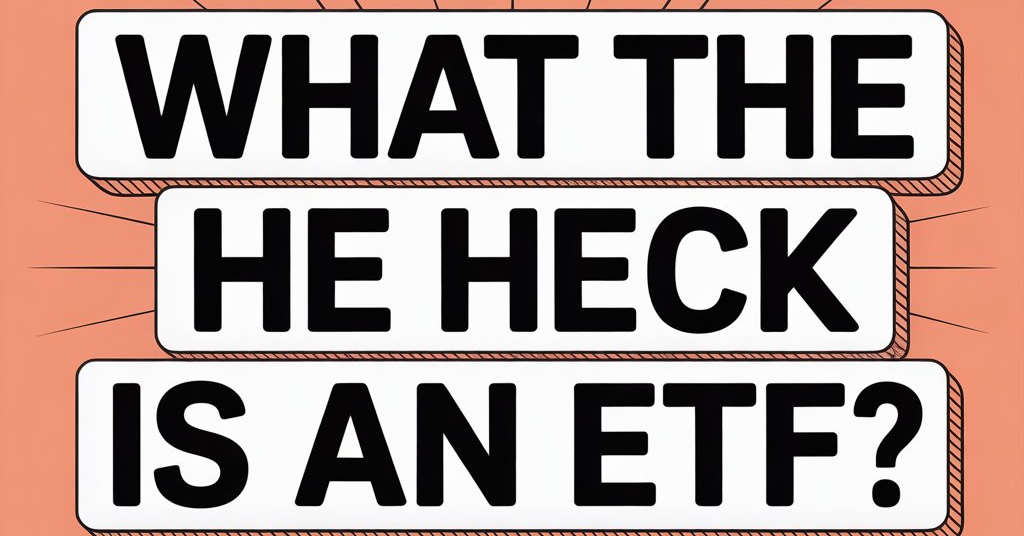If you have ever browsed finance websites, listened to podcasts, or scrolled through investing TikToks, you have probably heard the term ETF thrown around. But for many beginners, the first reaction is often: “What the heck is an ETF?”
Don’t worry—you are not alone. ETFs, or exchange-traded funds, have become one of the most popular ways to invest in the United States, with trillions of dollars managed inside them. They are flexible, cost-effective, and beginner-friendly. This blog will explain ETFs step by step—what they are, how they work, why they matter, types of ETFs, real-world examples, and even sample calculations. By the end, you’ll understand ETFs well enough to decide if they belong in your investment plan.
✅ What Is an ETF?
ETF stands for Exchange-Traded Fund. Think of it as a basket of investments. Instead of buying individual stocks one by one, you buy one “basket” that already includes many stocks, bonds, or even commodities like gold.
Here’s the key part:
- ETFs trade on stock exchanges (like the NYSE or NASDAQ) just like regular stocks.
- Their price changes throughout the day, unlike mutual funds which are priced only once per day.
📌 Example:
If you buy 1 share of the SPDR S&P 500 ETF (ticker: SPY), you instantly own tiny pieces of all 500 companies in the S&P 500 index—companies like Apple, Microsoft, Amazon, and Coca-Cola.
So, instead of buying 500 different stocks, you just buy one ETF.
✅ Why Do ETFs Matter?
ETFs have become a favorite for U.S. investors because they combine the best of both worlds: the diversification of mutual funds with the flexibility of stocks.
Here are the key benefits:
- Diversification in One Trade
- One ETF share spreads your risk across dozens or even thousands of securities.
- One ETF share spreads your risk across dozens or even thousands of securities.
- Low Cost
- ETFs usually have lower fees (expense ratios) than mutual funds.
- Vanguard and iShares ETFs have expense ratios as low as 0.03%.
- ETFs usually have lower fees (expense ratios) than mutual funds.
- 📌 Example Calculation:
If you invest $10,000 in an ETF with a 0.05% expense ratio:
- Annual fee = 0.05% × 10,000 = $5 per year.
That’s cheaper than many mutual funds, which can charge 1% or more ($100 per year).
- Annual fee = 0.05% × 10,000 = $5 per year.
- Tax Efficiency
- ETFs are designed to avoid triggering frequent taxable events. This means less capital gains tax compared to many mutual funds.
- ETFs are designed to avoid triggering frequent taxable events. This means less capital gains tax compared to many mutual funds.
- Liquidity
- ETFs can be bought and sold anytime during market hours.
- This makes them more flexible than mutual funds, which only trade once per day.
- ETFs can be bought and sold anytime during market hours.
✅ How Does an ETF Work?
ETFs have a unique structure that keeps their price close to the value of the assets they hold.
- Net Asset Value (NAV)
- Each ETF has a NAV, which is the value of all its holdings divided by the number of shares.
- Each ETF has a NAV, which is the value of all its holdings divided by the number of shares.
- Arbitrage Mechanism
- If ETF shares trade too high above NAV, large institutions (called authorized participants) step in to create new shares by buying the underlying assets.
- If ETF shares trade below NAV, they redeem shares by selling assets.
- This keeps ETF prices in line with the true value of their holdings.
- If ETF shares trade too high above NAV, large institutions (called authorized participants) step in to create new shares by buying the underlying assets.
📌 Example Calculation:
Suppose an ETF holds $1 billion in stocks and has 10 million shares outstanding.
- NAV = $1,000,000,000 ÷ 10,000,000 = $100 per share.
If the ETF is trading at $102, authorized participants will buy the underlying stocks, create ETF shares, and sell them at $102—bringing the price back toward $100.
✅ Types of ETFs
ETFs come in many flavors. Here are the main types you’ll encounter:
- Index ETFs
- Track a market index like the S&P 500.
- Example: SPY (S&P 500 ETF).
- Track a market index like the S&P 500.
- Bond ETFs
- Invest in government or corporate bonds.
- Example: iShares U.S. Treasury Bond ETF.
- Invest in government or corporate bonds.
- Sector & Thematic ETFs
- Focus on industries like tech, healthcare, or renewable energy.
- Example: Technology Select Sector SPDR ETF (XLK).
- Focus on industries like tech, healthcare, or renewable energy.
- Commodity ETFs
- Give exposure to commodities like gold or oil.
- Example: SPDR Gold Shares (GLD).
- Give exposure to commodities like gold or oil.
- International ETFs
- Invest in foreign markets outside the U.S.
- Example: Vanguard FTSE Emerging Markets ETF (VWO).
- Invest in foreign markets outside the U.S.
- Actively Managed ETFs
- Fund managers handpick securities, trying to beat the market.
- Fund managers handpick securities, trying to beat the market.
- Inverse and Leveraged ETFs (High Risk)
- Inverse ETFs move opposite to an index.
- Leveraged ETFs amplify daily returns (2x or 3x).
- Example: ProShares UltraPro QQQ (TQQQ).
⚠️ These are risky and not recommended for beginners.
- Inverse ETFs move opposite to an index.
✅ ETF vs Mutual Fund
| Feature | ETF | Mutual Fund |
| Trading | All day like a stock | Only once daily |
| Minimums | Price of 1 share (can be fractional for $1) | Often $1,000+ |
| Fees | Very low (0.03%–0.10%) | Higher (0.50%–1% or more) |
| Taxes | More tax efficient | Often less tax efficient |
📌 Example:
Investing $20,000 in an ETF at 0.05% fee costs just $10 per year.
Investing the same in a mutual fund at 1% costs $200 per year.
Over 20 years, that difference could add up to thousands of dollars.
Also Read: 7 of the Best Investments Young Australians Can Make This Year
✅ Pros and Cons of ETFs
Pros
- Easy diversification.
- Low cost.
- Tax efficiency.
- Liquidity and flexibility.
- Wide variety to choose from.
Cons
- Too much choice can overwhelm beginners (over 4,000 ETFs in the U.S.).
- Some ETFs with low assets may shut down.
- Leveraged/inverse ETFs carry high risk.
- Bid-ask spreads can add hidden costs for illiquid ETFs.
✅ Real-World ETF Example with Numbers
Let’s say you invest $5,000 in SPDR S&P 500 ETF (SPY) at $500 per share.
- You buy 10 shares ($5,000 ÷ $500).
- The expense ratio is 0.09%, so annual fee = $4.50.
- If the S&P 500 grows by 10% in a year:
- Your investment = $5,500.
- Subtract $4.50 fee → $5,495.50.
- Your investment = $5,500.
Net return: ~9.91% instead of 10%.
That’s the beauty of ETFs—fees are so low that they hardly eat into your returns.
✅ Building an ETF Portfolio (with Example Allocation)
A simple beginner-friendly ETF portfolio could look like this:
- 60% U.S. Stocks – SPY (S&P 500 ETF).
- 20% International Stocks – Vanguard Total International Stock ETF (VXUS).
- 20% Bonds – iShares Core U.S. Aggregate Bond ETF (AGG).
📌 Example:
If you invest $50,000:
- $30,000 in SPY.
- $10,000 in VXUS.
- $10,000 in AGG.
This portfolio spreads risk across U.S. equities, global markets, and bonds—all with just three ETFs.
✅ How to Buy Your First ETF
- Open a brokerage account – Popular U.S. brokers include Vanguard, Fidelity, Charles Schwab, or Robinhood.
- Search for the ETF – For example, type “SPY” or “VTI.”
- Choose your order type:
- Market order (buy instantly at current price).
- Limit order (set your price).
- Market order (buy instantly at current price).
- Buy in whole or fractional shares. Some brokers let you start with as little as $1.
- Hold, monitor, and rebalance yearly.
✅ Final Thoughts
So, what the heck is an ETF? It’s a low-cost, flexible, and beginner-friendly investment tool that gives you instant diversification. Whether you want to track the entire U.S. stock market, focus on tech, invest in bonds, or even add gold, there’s an ETF for you.
By understanding how ETFs work—through examples, numbers, and comparisons—you can make smarter investing decisions. Start small, choose simple ETFs, and build your portfolio step by step. Over time, ETFs can help you grow wealth steadily while keeping costs under control.
👉 If you’re a beginner investor in the U.S., ETFs may be one of the best first steps into the stock market.



